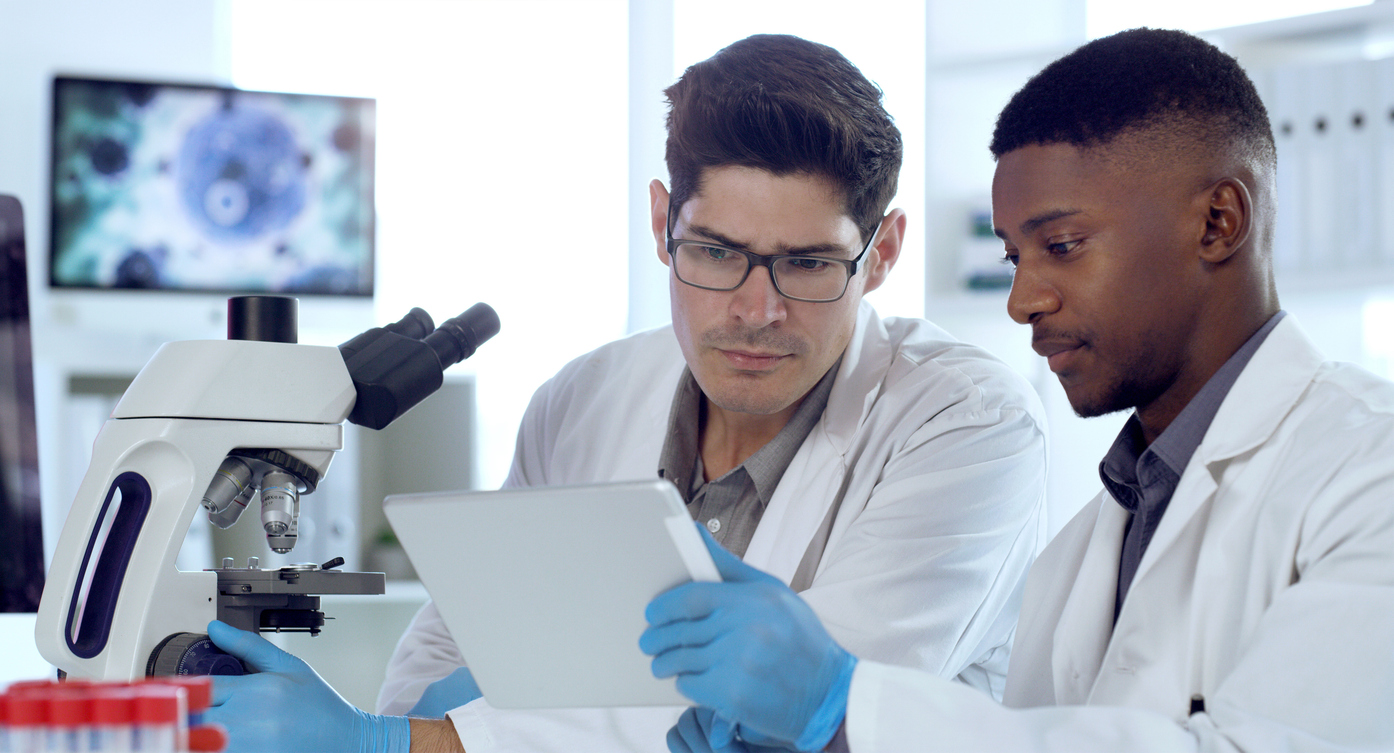R&D has evolved into dynamic, collaborative teams driving innovation. To be first to market, R&D teams need to exceed in collaboration, within labs, cross labs, and across scientific disciplines. Organizations are now investing in the technical infrastructure to support cross-disciplinary teams, speeding up experimentation and discovery. We explored this topic in our recent webinar: Advancing R&D with Collaboration & Cross-Discipline Science. Read on for a summarized preview of the webinar, or watch the full video, below.
The Webinar Agenda
- Brian Buntz, Editor-in-Chief of R&D World, interviews Jenny Hu of Labstep and Matt Armbrust, researcher at the Sarafan ChEM-H Stanford Innovative Medicines Accelerator
- The current state of scientific experimentation from practitioners and how R&D has changed throughout the years.
- How organizations are breaking down barriers between R&D labs and scientific disciplines.
- Actionable takeaways and practical strategies for collaborating more effectively within and across labs and scientific disciplines.

In what ways does collaboration drive innovation and IP (intellectual property) development faster?
Jenny Hu: There are so many ways, but the one that resonates with me, and is core to the culture of the Labstep team, is “cross-pollination.” Bringing together diverse perspectives can foster more creativity, ideation, and leading to faster problem-solving and also avoid duplication of efforts.
This is especially true after the Covid-19 pandemic, where we’ve seen unprecedented levels of collaboration between scientists around the world. I came across a report that stated around 75 thousand papers were published within the first year of the pandemic in 2020, with 25% coming from international collaborations.
We’ve also touched upon this in our previous Replication Challenge webinar, where collaboration between academia and industry helps with resource allocation, access to funding, and also strengthens the credibility of research findings when there’s more validation done in alternative settings.

Jenny Hu serves as the Head of Customer Success & Growth at STARLIMS, spearheading the commercial team’s efforts to drive growth for the Labstep ELN within STARLIMS. Jenny commenced her journey at Labstep in 2019, initially assuming the role of Implementation Manager. In this capacity, she adeptly managed pre-sales and post-sales technical and customer experience initiatives. A computational geneticist by training, Jenny’s prior experience in scientific research during her academic tenure provided her with a solid foundation to foster strong relationships with Labstep’s R&D clientele, resulting in enhanced adoption, retention, and expansion rates.
Matt, how does your organization approach collaboration and interdisciplinary collaboration as part of your R&D efforts?
Matt Armbrust: Interdisciplinary research and collaboration is built into the fabric of our lab and institute. Starting with the name, Sarafan ChEM-H, which stands for Chemistry, Engineering, Mathematics, and Humanities. We have a large number of institute scholars, faculty, and staff members that span across all these disciplines and bring unique perspectives to research that would otherwise be lost if we weren’t under the same roof actively sharing ideas.
For more specific examples: The Innovative Medicine Accelerator is disease agnostic and accepts proposals from any and all disciplines that have an idea for a successful therapeutic. My lab specifically, Protein Engineering, has an open-door approach to sharing data and communication with all the projects we collaborate on. All of our collaborators have direct access to our data and we hold regular meetings with them to share our findings and receive feedback on how to move forward with discoveries.
What are your thoughts on cross-discipline collaboration? Do you foresee R&D science getting more integrated?
Jenny Hu: I truly believe cross-discipline collaboration has always been an essential part of R&D. When I was working in the lab at McGill University in Canada, I was part of a research group that consisted of molecular biologists, biomedical engineers and orthopedic surgeons, all working together to tackle one of humanity’s greatest enemies: chronic back pain.
Fast forward to now, and there is an increasing need for R&D to be more integrated, especially as the complexity of scientific challenges grows. I’ve witnessed first hand the positive effect of technologies like Labstep, and how it can bridge the gap between biologists and chemists, resulting in more efficiency and accuracy in drug discovery research.
I also believe that the boundaries of disciplines are becoming more fluid, because I’m working with many researchers that have hybrid skill sets, for example, chemical engineers who are also trained in data science or bioinformaticians with a molecular biology background.
I don’t think knowledge of one field alone is enough to solve multi-dimensional problems we’re facing today, which means working with a cross-disciplinary team is becoming a necessity in modern R&D.
Matt Armbrust has worked as a Research Associate at the Protein Engineering Knowledge Center (PEKC) under the Innovative Medicines Accelerator (IMA) for over 2 years. The IMA is dedicated to supporting the discovery and engineering of novel biotherapeutics by directly collaborating with faculty at Stanford University. Matt directly contributes to this pipeline by performing critical experiments as a researcher in the drug prototyping process. Prior to his role at the IMA, Matt earned dual B.S. degrees in Biological Engineering and Biochemistry at Utah State University and performed undergraduate research on novel CRISPR systems.

Stanford Innovative Medicines Accelerator, Protein Engineering Knowledge Center
Can you describe your R&D laboratory processes, and the scientific disciplines involved? Do things get transferred from multiple lab teams or disciplines?
Matt Armbrust: My lab is called the Protein Engineering Knowledge Center. We are a subset of the IMA and a small team of about 10 people. The field of protein engineering is complex and requires expertise from a wide range of disciplines, including: molecular biology, biochemistry, biophysics, bioinformatics, chemistry, cell biology, and more.
Our director, Adrian Hugenmatter, had a unique vision and approach when building our team to cover all disciplines involved in our science. Each person from our team comes from a unique background and is an expert in their respective fields.
For example, I joined the team with a lot of experience in biochemistry and protein purification. One of the first things I was tasked with when I was hired was setting up our protein purification instrument and developing protocols and workflows that would then be shared with the rest of the lab.
Can you share a recent example of how collaboration has accelerated R&D experimentation in your organization?
Matt Armbrust: Absolutely! One of the most important parameters we look at when developing a novel therapeutic is called pharmacokinetics (PK). In short, PK is a measure of how long a drug is actively circulating through blood/serum and tissues to perform its job.
Once we identify lead candidates for a given disease modality, PK is one of the first things we need to measure to make sure the drugs behave well once injected into an organism.
To do so, we collaborate directly with an in-house team specializing in Preclinical Pharmacology. We share an office with this small team of experts that has performed countless PK experiments. This dramatically accelerates our timelines for drug discovery and enables us to purify a molecule one week and have it already injected into mice the next week for PK measurement.
What strategies do you think organizations need to break down barriers between R&D labs and different scientific disciplines?
Jenny Hu: From my experience, organizations are more successful in bridging the gaps between different teams when one or more leaders of the business take ownership in facilitating those connections and start fostering a culture of cross-disciplinary collaboration.
This can be appointing champions from different research teams to arrange regular touch points, where they can strategize on mutual research goals. For example, how to standardize common R&D methods, improve information transparency for resource pooling, and having the opportunity to help other teams learn about new fields, tools, and relevant emerging technologies.

R&D World
Brian Buntz is an award-winning journalist and editor with close to 20 years of experience covering a wide range of life sciences, science, and technology topics. As Editor-in-Chief of R&D World at WTWH Media, Brian leads editorial strategy and content creation, focusing on emerging technologies in industries such as drug discovery and development, academic research, and the tech sector.
Before coming to WTWH Media, Brian held leadership roles at Informa and UBM, focusing on subjects ranging from IoT, data science, and medical devices, where he significantly increased website traffic and engagement through strategic content development. In his spare time, he explores creating tools and apps using Python, APIs, large language models, and NLP tools to analyze and visualize data. Brian is also the recipient of a national Azbee Award of Excellence for business journalism.
How can an R&D lab ensure effective communication and knowledge sharing among diverse teams working on complex R&D projects?
Jenny Hu: Start by establishing dedicated channels of communication to connect the people. Having more of a hierarchy-free environment can be helpful in fostering a culture of collaboration.
The next step is to invest in technologies that can help make collaboration easier. I’ve worked with many research organizations where individual teams have their own ways of working that’s evolved in isolation. This then introduces lots of data silos, which adds to the challenge of data transparency and knowledge sharing.
One approach to solve this is to search for a platform with the flexibility to accommodate for multi-disciplinary workflows. For example, a scientist who works in the exploratory stage of a research documents data in a very different way to a scientist that is in the production stage, which means it’s important for research teams to work together in identifying the key R&D use cases, and implement a centralized solution that provides a good user experience for everyone.
In addition, many research teams I’ve worked with also value solutions that can be easily integrated with other systems or processes.
In an ideal world, we all want a digital system that can do everything, but in reality, a R&D workflow will typically require several purpose-specific tools for data processing and then transferred to a centralized location for consolidation. What is less than ideal is how scientists often have to operate now, which is a combination of manual effort along with multiple disconnected systems.
Jenny Hu, Head of Customer Success, Labstep a STARLIMS Company
What are some of the biggest challenges you’ve faced when integrating teams from different scientific backgrounds, and how have you overcome them?
Matt Armbrust: The biggest challenge by far is establishing a centralized database that is followed by all members of the organization. I joined the protein engineering team during its infancy, so I have a unique perspective on the challenges of data organization and convincing people from different backgrounds to get on the same page.
One of the first challenges we faced as a lab was finding an Electronic Laboratory Notebook (ELN) that offered features that were desirable by everyone on the team.
In the end, we chose Labstep due to its user-friendly interface and ability to organize data easily across multiple projects.
Matt Armbrust, Research Associate in Protein Engineering at Sarafan ChEM-H | Stanford University.
In general, people coming from industry are accustomed to more strict data organization protocols than those coming from academia backgrounds. Most independent academic labs do not take the time to establish such systems, and when a team such as ours is established that combines people from all backgrounds, there can be a lot of growing pains in that area. Some of the solutions we have implemented include:
- A standardized nomenclature/naming system for all the molecules we produce and use in our lab (DNA, proteins, etc.)
- A standardized nomenclature/naming system for data files generated by each instrument in our lab.
- Experiment and protocol templates in Labstep to provide consistency across all entries in our ELN
- Barcoding system for ordering of consumables and reagents (work-in-progress)
Can you discuss any specific tools or platforms that have been particularly effective in facilitating collaboration between different researchers, labs, or scientific teams?
Matt Armbrust: Within Labstep, the most important tool that we have utilized is writing standardized Protocols for all the procedures we perform in the lab. This allows us to write detailed methods developed by someone knowledgable with the science and then share them to be used by the rest of the lab.
For example, I wrote methods for protein purification that are now used by other members of my lab that previously did not have any experience in protein purification.
Labstep also facilitates efficient communication between us and the labs that we collaborate with. We can easily export experiments and data and quickly send them over to our collaborators in a report format. Some of our collaborators have even opted to have their own accounts in Labstep for direct access to our database.
What advice would you give to organizations looking to foster a more collaborative and innovative R&D environment?
Matt Armbrust: My biggest piece of advice would be to dedicate time and resources to establishing an organized database in the early stages of a lab/institute/company.
So much time and money is lost on repeating experiments that have already been done a few years prior simply because the data was lost or is not interpretable. I have a firsthand example of this where a labmate moved on to a different company and left a lot of data in disarray. When we picked up the project to move it forward, we had to repeat a lot of what had already been performed which is a huge waste of resources.
If you can establish a system from the beginning and get everyone involved in the research to buy into it, it sets the stage for a much more efficient workflow. It is a lot easier to collaborate on projects with my colleagues who share the same values of organization that I do.
I will often jump in between projects where I am needed and it can be difficult doing so if the data is uninpterpretable.
Jenny Hu: As Matt mentioned, it can be challenging and overwhelming for research teams when it comes to implementing systematic changes, whether it’s overhauling processes, standardizing data capture or implementing new software. I always advise my customers to see this more as a journey rather than an overnight change.
- Start by digitizing anything that’s still recorded on paper and store data on shared drives that’s accessible to everyone.
- Use cloud-based systems, as it’s better for real-time collaboration and connecting teams working from different locations.
- Encourage shared skill development so that there is redundancy within the team as well as creating more opportunities for collaboration
- If you’re making a change, test it out with a smaller group that represents the different teams first. This takes into account each team’s requirements and it’s a lot easier to convince the wider team when you can show some evidence of the change being effective, even if it’s a proof of concept.
Lastly, I would encourage everyone to continue doing what you are doing today, joining webinars, exploring and learning new technologies that can help you better collaborate and innovate!

